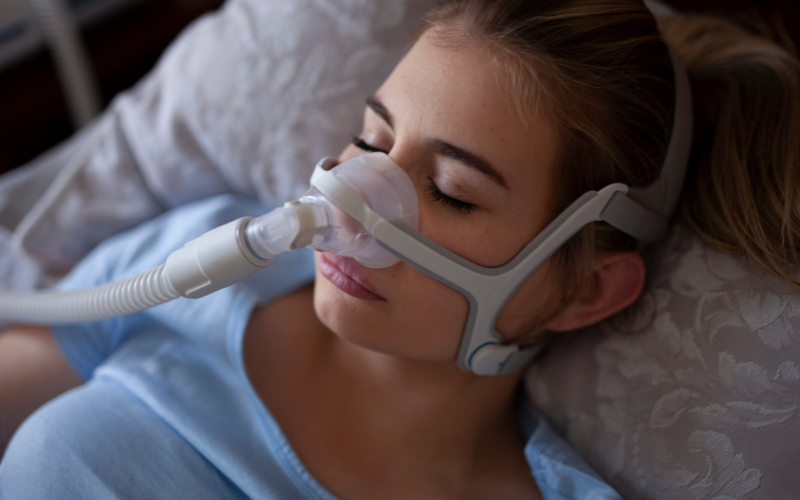If you have sleep apnea, here’s what to know about dental devices, tongue trainers, mouth tape, and more.
Consumer Reports | By Kevin Loria
When you have obstructive sleep apnea, or OSA addressing it is key. Left untreated, OSA is linked to daytime sleepiness and an increased risk of anxiety, diabetes, hypertension, and stroke.
With OSA, your breathing pauses during sleep because something blocks your airway, like your tongue or relaxed throat muscles, explains Richard Schwab, MD, chief of the division of sleep medicine at the University of Pennsylvania Perelman School of Medicine in Philadelphia. Losing weight, quitting smoking, and limiting alcohol can all help ease obstructive sleep apnea symptoms such as snoring, says Ana Krieger, MD, medical director of the Center for Sleep Medicine at Weill Cornell Medicine in New York City.

Sleep apnea’s severity is determined by something called your apnea-hypopnea index (AHI): the number of times per hour you fully or partially stop breathing for 10 seconds or longer. The primary treatment for people with moderate (15 to 29 AHI) or severe (30 AHI and higher) obstructive sleep apnea is a continuous positive airway pressure (CPAP) machine, which keeps your airway open by pumping air through a mask you wear over your mouth and/or nose when you sleep.
Many people have difficulty tolerating CPAP and don’t stick with it, however. The good news is that CPAP machines have become smaller and quieter, with more comfortable options available. And for some people with mild (5 to 14 AHI) or even moderate OSA, less invasive alternatives to CPAP may be worth considering.
A Common CPAP Alternative
A dental device designed to move the jaw so that the tongue shifts toward the front of the mouth can help keep the airway open. It’s one of the primary alternatives to CPAP, Schwab says, and can also be used with CPAP to help make severe obstructive sleep apnea milder.
A dentist who specializes in sleep medicine (find one at dentalsleep.org) will be able to customize its fit to help your breathing without causing harm to your bite or teeth, says Kevin Postol, DDS, president-elect of the American Academy of Dental Sleep Medicine. These custom-made oral appliances can cost between $2,000 and $4,000, according to Schwab, but may be covered by insurance.
There are much cheaper options available online to treat snoring, but experts say these may not help with OSA, and could move teeth out of place or cause jaw issues if they’re not properly fitted.
Other Sleep Apnea Treatments
- Position therapy: For some, sleeping on the back can make obstructive sleep apnea dramatically worse. In these cases, switching to side sleeping—perhaps using pillows or a tennis ball attached to a shirt back—can sometimes get AHI into the mild range.
- Tongue trainer: In 2021, the Food and Drug Administration approved a tongue-stimulating device for mild sleep apnea called eXciteOSA, which people wear for 20 minutes a day for six weeks and then 20 minutes a couple of times a week indefinitely. It costs $1,650 and is not covered by insurance. More research is still needed on its efficacy, Krieger says.
- Mouth tape: While it’s a popular suggestion that may reduce snoring, taping the mouth shut is not an effective or safe option for people with obstructive sleep apnea, Schwab says.
- Surgery: Some people who can’t tolerate CPAP have upper airway surgery to reduce the size of their soft palate or other tissue in their throat. But such options don’t always work, have serious potential complications, and cannot be reversed. So in general, they should not be first-line treatments, Schwab says. A newer option is a surgically implanted device called Inspire. Approved in 2014, it stimulates a nerve that moves your tongue to keep your airway open. Inspire can be removed if it is not tolerated, but it should also be tried only if someone is unable to use CPAP, and it is not an option for everyone.
Could Weight Loss Meds Treat OSA?
Because sleep apnea is an anatomic disorder, drugs typically have not been effective, Schwab says. But GLP-1 weight loss medications such as Wegovy may be used in the future, perhaps in concert with an oral appliance or airway surgery.
That’s on the table because obesity is a primary risk factor for OSA: One 2022 study found that for every 7-pound drop in weight, there’s a roughly 7 percent drop in AHI. But more research on using these meds for obstructive sleep apnea is needed.
Editor’s Note: This article also appeared in the April 2024 issue of Consumer Reports On Health.
